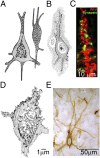Very long-term memories may be stored in the pattern of holes in the perineuronal net
- PMID: 23832785
- PMCID: PMC3725115
- DOI: 10.1073/pnas.1310158110
Very long-term memories may be stored in the pattern of holes in the perineuronal net
Abstract
A hypothesis and the experiments to test it propose that very long-term memories, such as fear conditioning, are stored as the pattern of holes in the perineuronal net (PNN), a specialized ECM that envelops mature neurons and restricts synapse formation. The 3D intertwining of PNN and synapses would be imaged by serial-section EM. Lifetimes of PNN vs. intrasynaptic components would be compared with pulse-chase (15)N labeling in mice and (14)C content in human cadaver brains. Genetically encoded indicators and antineoepitope antibodies should improve spatial and temporal resolution of the in vivo activity of proteases that locally erode PNN. Further techniques suggested include genetic KOs, better pharmacological inhibitors, and a genetically encoded snapshot reporter, which will capture the pattern of activity throughout a large ensemble of neurons at a time precisely defined by the triggering illumination, drive expression of effector genes to mark those cells, and allow selective excitation, inhibition, or ablation to test their functional importance. The snapshot reporter should enable more precise inhibition or potentiation of PNN erosion to compare with behavioral consequences. Finally, biosynthesis of PNN components and proteases would be imaged.
Keywords: extracellular matrix; genetically encoded reporters; memory; plasticity; protein turnover.
Conflict of interest statement
The author declares no conflict of interest.
Figures



References
-
- Sacktor TC. How does PKMζ maintain long-term memory? Nat Rev Neurosci. 2011;12(1):9–15. - PubMed
Publication types
MeSH terms
Substances
Grants and funding
LinkOut - more resources
Full Text Sources
Other Literature Sources
Medical

